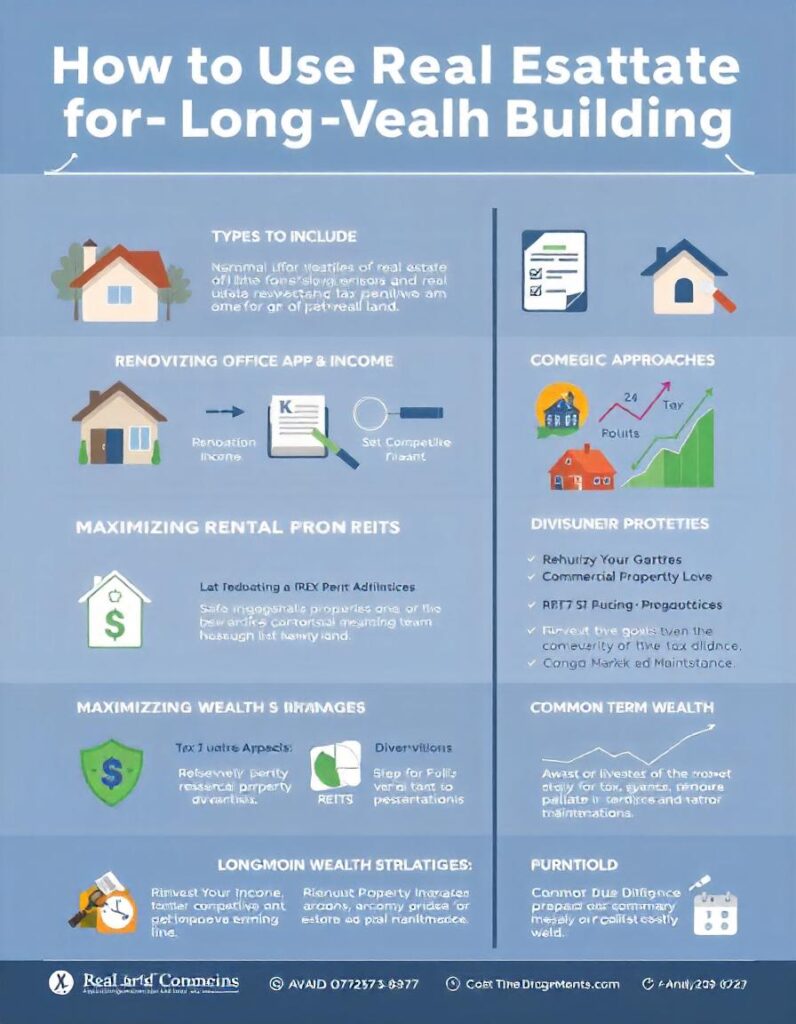Real estate has long been a cornerstone of wealth building and financial security. From rental properties to commercial investments, real estate offers diverse opportunities to accumulate wealth over time. Understanding how to leverage real estate effectively can help you build a robust financial future and achieve long-term financial goals. This guide explores strategic approaches to using real estate for wealth building, providing valuable insights for those seeking to maximize their real estate investments.
1. Understanding Real Estate as an Investment
1.1. Types of Real Estate Investments
- Residential Properties: Includes single-family homes, multi-family units, and vacation rentals. These properties can generate rental income and appreciate in value.
- Commercial Properties: Comprises office buildings, retail spaces, and industrial properties. They typically offer higher rental yields but may require more significant capital.
- Real Estate Investment Trusts (REITs): Companies that own or finance income-producing real estate. REITs provide a way to invest in real estate without owning physical property.
- Raw Land: Undeveloped land that can be purchased for future development or appreciation.
1.2. Benefits of Real Estate Investment
- Steady Income: Rental properties can provide consistent cash flow.
- Appreciation: Real estate generally appreciates in value over time.
- Tax Advantages: Property owners can benefit from tax deductions, depreciation, and other incentives.
- Diversification: Real estate adds diversity to your investment portfolio, reducing overall risk.
2. Strategic Approaches to Building Wealth with Real Estate
2.1. Start with a Clear Investment Strategy
- Define Your Goals: Determine whether you want to focus on rental income, property appreciation, or both.
- Research the Market: Analyze local real estate markets to identify areas with strong growth potential and favorable rental conditions.
2.2. Leverage Financing Options
- Mortgage Financing: Use mortgages to purchase property with a relatively small down payment, allowing you to leverage your investment.
- Home Equity Loans: Tap into the equity of your existing properties to finance new investments.
- Partnerships: Consider partnering with other investors to share risks and capital requirements.
2.3. Focus on Location and Property Value
- Choose High-Demand Areas: Invest in locations with strong demand for rental properties, good schools, and access to amenities.
- Evaluate Property Condition: Inspect properties thoroughly to assess potential repair costs and future value.
2.4. Maximize Rental Income
- Enhance Property Appeal: Make improvements to increase property value and attract higher-quality tenants.
- Set Competitive Rent: Research local rental rates to set competitive and profitable rent prices.
- Minimize Vacancies: Maintain properties well and offer incentives to reduce vacancy rates.
2.5. Manage Properties Effectively
- Hire a Property Manager: Consider employing a property management company to handle tenant relations, maintenance, and other responsibilities.
- Stay Organized: Keep detailed records of income, expenses, and property management activities for effective oversight and tax reporting.
2.6. Diversify Your Real Estate Portfolio
- Invest in Different Property Types: Spread investments across residential, commercial, and raw land to diversify risk and income sources.
- Explore Geographic Diversification: Consider investing in properties in different locations to mitigate local market fluctuations.
3. Long-Term Wealth Building Strategies
3.1. Reinvest Profits
- Reinvest Rental Income: Use rental income to acquire additional properties or invest in property improvements.
- Sell and Upgrade: Consider selling properties that have appreciated significantly and reinvesting the proceeds into higher-value assets.
3.2. Plan for Tax Efficiency
- Utilize 1031 Exchanges: Defer capital gains taxes by exchanging one investment property for another of equal or greater value.
- Take Advantage of Deductions: Claim deductions for mortgage interest, property taxes, and depreciation to reduce taxable income.
3.3. Prepare for Market Fluctuations
- Build a Financial Cushion: Maintain reserves to cover unexpected expenses and market downturns.
- Monitor Market Trends: Stay informed about real estate market trends and economic factors that could impact your investments.
4. Common Pitfalls to Avoid
4.1. Overleveraging
Avoid taking on excessive debt that could strain your finances and increase risk. Ensure that you have sufficient cash flow to cover mortgage payments and other expenses.
4.2. Ignoring Due Diligence
Thoroughly research properties and markets before making investment decisions. Neglecting due diligence can lead to costly mistakes and underperforming investments.
4.3. Underestimating Costs
Account for all associated costs, including maintenance, property management fees, and potential vacancies. Failing to budget for these expenses can impact profitability.
